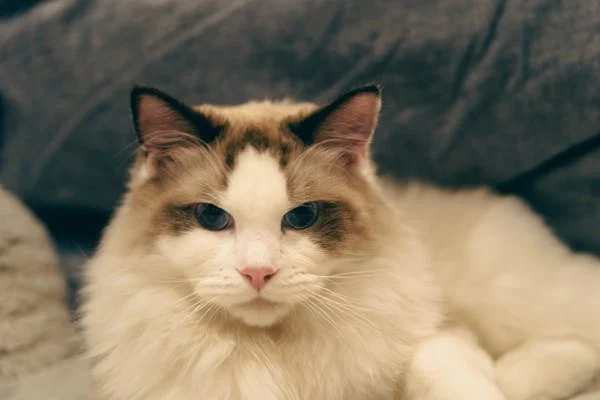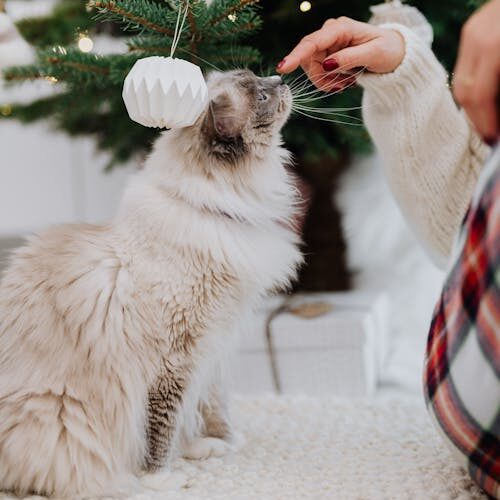Ragdoll cats, with their striking blue eyes, silky fur, and gentle demeanor, have captured the hearts of cat lovers worldwide. However, one of their most intriguing and endearing traits is their tendency to go limp when picked up, earning them the nickname “floppy cats.” This unique behavior has puzzled and fascinated many, leading to various theories and explanations.
In this comprehensive blog post, we’ll delve into the reasons behind this peculiar Ragdoll trait, explore the breed’s history, and address some frequently asked questions about these charming felines.
Why Do Ragdoll Cats Go Limp?
Ragdoll cats are known for their endearing tendency to go limp and relaxed when held, which is how they got their name. While the exact reason is not fully understood, there are a few theories.
One is that it reminds them of being carried as kittens by their mother, triggering a reflex to go limp. Another theory is that Ragdolls experience a release of “feel-good” hormones like serotonin and oxytocin when held, causing them to relax.
However, not all Ragdolls consistently display this “floppy” behavior – it depends on the individual cat’s personality. Ultimately, animal experts believe the Ragdoll flop is a sign of the cat feeling completely safe, trusting, and content when being held by humans

Is Going Limp a Defense Mechanism?
You may be wondering if the Ragdoll’s tendency to go limp is some kind of defense mechanism, like “playing dead.” However, animal experts don’t believe this is the case. The behavior is not fearful or anxiety-based. In fact, if a Ragdoll is scared or uncomfortable being held, they are more likely to tense up or struggle rather than relax and go limp.
Instead, the Ragdoll flop is a sign of positive emotions – trust, contentment, and happiness. These cats simply love being close to their humans and melt with joy into their arms! Going limp is the ultimate sign of a strong bond between a Ragdoll and their person.

What Makes Ragdoll Cats Unique?
Ragdoll cats are often celebrated for their dog-like personalities, making them a unique and special breed among cats. They are known for their sociable and affectionate nature, often following their owners from room to room and responding to their names, much like a dog would.
Ragdolls are also known for their gentle and laid-back demeanor, which allows them to get along well with children and other pets, including dogs. This combination of traits makes them not only charming but also adaptable companions in diverse household settings
Are Ragdoll Cats Good for Families?
Ragdolls make excellent family pets due to their docile, affectionate, and gentle nature. They are often described as having dog-like qualities, such as being loyal, following their owners around, and even playing fetch. Ragdolls are known for their patience and tolerance, making them well-suited for households with children. They rarely use their claws during playtime and are generally not aggressive, even when provoked.
In terms of lifespan, Ragdolls typically live between 12-15 years, with some living up to 20 years or longer with proper care.

Caring for Your Floppy Friend
While Ragdolls are relatively low-maintenance cats, they do require regular grooming to keep their semi-long coats in good condition. Their social nature also means they do not like to be left alone for extended periods, so providing them with toys and interactive play is crucial for their well-being. Regular veterinary check-ups are essential to monitor for health issues common to the breed, such as hypertrophic cardiomyopathy and kidney disease.
Conclusion
Ragdoll cats are truly one-of-a-kind, with their endearing tendency to go limp when held, their gentle and affectionate nature, and their playful and curious spirit. Whether you are a first-time cat owner or an experienced feline enthusiast, a Ragdoll cat can bring joy, companionship, and plenty of cuddles to your life.
By understanding the reasons behind the Ragdoll flop and appreciating the unique traits that make these cats so special, you can create a loving and nurturing home environment for your floppy feline friend. So, the next time your Ragdoll goes limp in your arms, remember that it’s a sign of their trust, contentment, and unconditional love for you.
FAQs:
Q: Do all Ragdoll cats go limp when held?
A: While many Ragdolls exhibit this trait, not all will go completely limp. Some may maintain a bit of tension or prefer not to be held.
Q: At what age do Ragdoll kittens start going limp?
A: Ragdoll kittens typically start showing signs of their floppy nature around 3-4 months old, as they become more trusting and relaxed with their owners.
Q: Can Ragdolls be trained to go limp on command?
A: While you can’t train a Ragdoll to go limp, you can create a calm and secure environment that encourages them to relax when held.

Hey guys, My name is Simon Smith. I’m from Canada and live near Victoria
I live with my sweet family and have 20+ Ragdolls of different types. I love them as my children. My profession is as a hotel manager.
I love to keep Ragdolls and grow their breeder case. I have 7 years of experience.
I’m an expert in cat care. So, I’m here to provide you with new information about my cats daily. This is my blog website, so I request that you kindly visit our site daily.
If you’re a Ragdolls lover and you have any questions or confusion about cats, text me on the Contact Us page or Gmail.
Thank u
